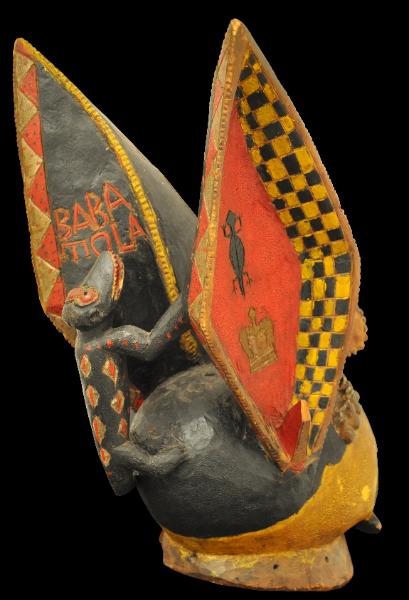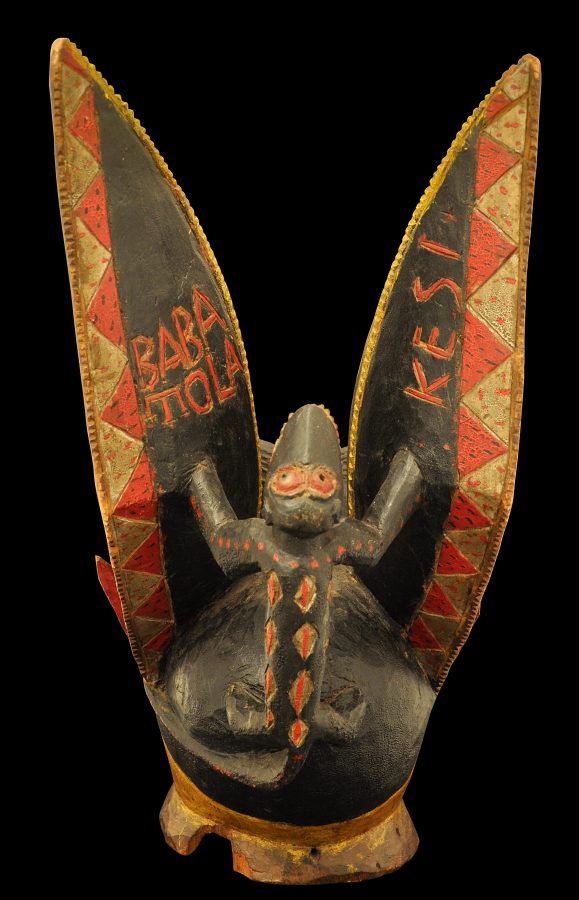This monumental mask, which was collected by the Australian artist Donald Friend in either 1938 or 1939 when he lived in Nigeria whilst painting, and serving as the financial advisor to the Ogoga of Ikerre, is of a type that was used for Egungun rituals – masquerades, designed to honour the ancestors. The headdress is signed by the artist – his name, Baba Mola, and his town, Kesi, are carved into the headdress as an integral part of its design.
The priest-like figure who performs the ritual is also known as an Egungun. Friend, in his diaries that were published in 2001, talks about going to meet the Ogoga’s Egungun:
‘He was not of the terrifying variety. He wore an enormous busby of black, white and heliotrope feathers and a mask of indigo, the usual streamers of palm, and trousers of Turkey carpet that were the gift of the Oba of Benin…Most of what he said was in parable form.’ (Gray, 2001, p. 77).
The Egungun served as a conduit between the ancestors and the living. The ancestors are deemed to be the creatures of two worlds. They are the spirits of the departed kings, founders and leaders, who return to the world of the living to see their families before departing into the spirit world. The Yoruba people believe that their ancestors can influence the fate or fortunes of the living.
Friend’s Egungun helmet mask is carved from a single piece of light wood. The facial part represents a male with a protruding beard. His eyes are classically almond-shaped. His pupils are pierced with circular holes. Eye lashes are painted with black paint around the eyes. His nose is strong, yet elegant. His thick lips are parted by two incisors. Three scarification lines are incised on the forehead and both cheeks, although those on the forehead are smaller. They are stained black. Such scarification marks are called pélé, which many communities in south-western Yorubaland regard as ‘gems’ on the human face. A small black cross is prominently placed on each cheek. Overall, the facial features exemplify superiority and serenity.
The upper part of the helmet mask is separated from the face with a band of gourds. These gourds are significant for their symbolic meaning. The form of gourd is often used in Yoruba carving to represent gun powder container. Therefore it is associated with hunting. Hunting was primarily every man’s daily chore. It involved certain degree of danger. Gourds were also used to store medicines and potions. Gourds often are incorporated into the design of the Egungun masks as talismanic devices.
The upper part of the helmet mask is also decorated with a double, hour glass-shaped tension drum (dundun) and a pair of over-sized ears, modelled after those of a hare. On their exterior, the ears are painted with bright red, yellow and black, with triangular motifs, wheels and panels of spiralling guilloches. Their interiors are painted with interlinked black and yellow squares on the edge, bright red in the middle, with a black lizard above a golden crown. The words ‘BABA MOLA’ and ‘KESI’ are inscribed on the back of the left and right ears respectively. A lizard is carved standing at the back of the mask. Its body is decorated with red dots and diamond-shaped motifs.
The mask has excellent patina, and exceptional provenance. There is a small chip to the back rim and other expected, minor losses. There are no cracks or repairs. Aesthetically, it is very similar to an example in the Rautenstrauch-Joest Museum, Cologne, which was carved by Oniyide Adugbologe, the best-known carver of Egungun masks.
Other similar Egungun helmet masks can be found in the Metropolitan Museum.
The Yoruba people have three major festivals at which such headdresses are used: the Efe/Gelede, the Egungun and the Epa/Elefon ceremonies.
The Egungun dancers are always men. Their identities are completely concealed by their costumes. They are clad in layers of sumptuous and multi-coloured cloths. These clothes are usually made up of layers of fabric panels adorned with sequins, mirrors, ribbons, cowrie shells and amulets. Their dance movements emphasise three essential elements: cloth, wind and strength. The manipulation of the cloth is important in creating a sense of theatre. The dancers walk in an exaggerated manner, which combines leaps and dances, to provoke the layers of cloth to rise, fall and whirl about.
Red, is the utmost important colour of the costume. It is associated with wealth and power, especially the supernatural power to terrorise the witches and the forces of pestilence. Red is also the colour of goddess Oya. Oya is the patroness of all masquerades because she is Egungun’s mother. Legend has it that Oya was married to Ogun but they could not have children. A diviner revealed to her that she could only have sons if she was possessed violently by a man. The god of thunder, Shango, took her. Oya and Shango had eight sons but they were all dumb. Oya consulted the diviner again, and she was advised to make sacrifices. The result was the birth of her ninth son, Egungun, who was not dumb but could only speak with an otherworldly voice.
Today, the Yoruba people form one of the largest tribes in west Africa. They number around 30 million and are predominant in Nigeria where they comprise 21 per cent of the population. Most Yoruba speak the Yoruba language. Today, 60 per cent are Christian and another 30 per cent are Muslim. But many, especially in rural areas, still practise old Yoruba traditions such as those based around ifa.
Illustrated / Published:
‘African Masks’, How to Spend it, The Financial Times, p. 65, October 15, 2016.


References
Bacquart, J. B., The Tribal Arts of Africa, Thames & Hudson, 1998.
Drewal, H. J., ‘Efe: Voiced Power and Pageantry’, in African Arts, Winter, vol. 7, 1974.
Drewal, H. J. & Drewal, M. T., Gelede: Art and Female Power among the Yoruba, Indiana University Press, 1983.
Fagg, W. & Pemberton, J. III., Yoruba: Sculpture of West Africa, Collins, 1982.
Gray, A. (ed.), The Diaries of Donald Friend, Vol. 1, National Library of Australia, 2001.
Lawal, B., The Gelede Spectacle: Art, Gender, and Social Harmony in an African Culture, University of Washington Press, 1996.
Roberts, A. F., Animals In African Art: From the Familiar to the Marvelous, Prestel, 1995.
Thompson, R. F.,African Art in Motion, University of California Press, 1974. :
Collected by the Australian artist Donald Friend in Nigeria when he lived there in 1938 and 1939.









